#AnyResearchisSymbolism
Explore tagged Tumblr posts
Text
Time symbolism
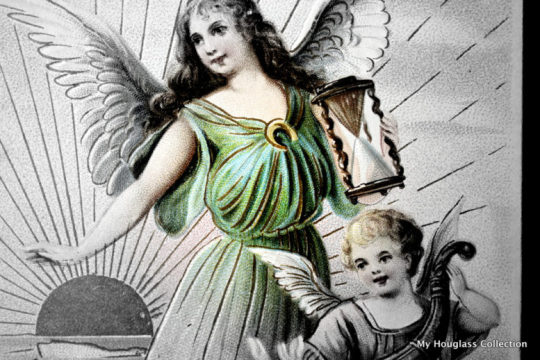
Time symbolism
What is the symbol of time? Symbol of Time is The Hourglass Symbol of Time, Personification of Time - Father Time Time symbolism - What is the symbol of time? My Hourglass Collection - Time and Hourglass History and Symbolism. Welcome to MHC Virtual Museum! See also Time synonyms, Time Philosophy and The Full History of Time

Marilyn Monroe Hourglass Figure paper-time
Any Research is Symbolism
Time Symbolism, or time semiotics as it’s known in technical circles, plays such a large part in human communication because people are constantly looking for deeper meaning. Whether it’s in the stars, drawn on a cave wall or in the newest visual content, we add such meaning to our communication through the use and interpretation of signs. The multiplication sign, also known as the times sign or the dimension sign, is the symbol X The multiplication sign (×), often attributed to William Oughtred (who first used it in an appendix to the 1618 edition of John Napier's Mirifici Logarithmorum Canonis Descriptio), apparently had been in occasional use since the mid 16th century SYMBOLIC TIME is understood to be the temporal form that organizes the symbols of a religious system into an order of periodicity. The analysis of symbolic time extends the understanding of religion as a symbolic system, so that the major functions of time within the system may be taken into account: the time intrinsic to the formation of religious symbols and to the ritual performance (i.e., the time that is internal to the sacred event)the connection that symbolic time has with the history and dynamic of a religious social bond, andthe time that is specific to the intentional life of the individual. Intentional Character of Symbolic Time Symbolic periodicity encompasses, in its temporal structure, both change and duration, implying a sheer sequence of symbolic events and also a type of internal correlation of events and symbols that reflects the functional unity of the interval of time and the continuity of its structure.
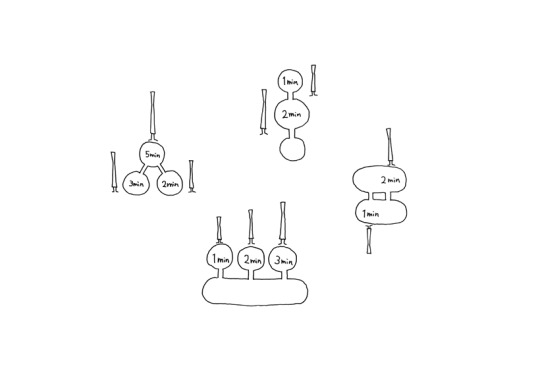
variations of time
Time symbolism
Time in physics. Time symbol science. From: Time in physics and time Science? Time in physics is defined by its measurement: time is what a clock reads. In classical, non-relativistic physics it is a scalar quantity and, like length, mass, and charge, is usually described as a fundamental quantity. Time can be combined mathematically with other physical quantities to derive other concepts such as motion, kinetic energy and time-dependent fields. Time constant In physics and engineering, the time constant, usually denoted by the Greek letter τ (tau), is the parameter characterizing the response to a step input of a first-order, linear time-invariant (LTI) system. The time constant is the main characteristic unit of a first-order LTI system. Physically, the time constant represents the elapsed time required for the system response to decay to zero if the system had continued to decay at the initial rate, because of the progressive change in the rate of decay the response will have actually decreased in value to in this time (say from a step decrease). In an increasing system, the time constant is the time for the system's step response to reach of its final (asymptotic) value(say from a step increase). In radioactive decay the time constant is called the decay constant (λ), and it represents both the mean lifetime of a decaying system (such as an atom) before it decays, or the time it takes for all but 36.8% of the atoms to decay. For this reason, the time constant is longer than the half-life, which is the time for only 50% of the atoms to decay. More about Time constant on Wiki. See also: Time in physics and time Science? MHC YouTube channel Symbolism of Melencolia I by Albrecht Dürer Create Ma, Upgrade Ma A New Theory On Time Frank LaCavera hourglass collections Time perception or sense of time Time and Text Lunar calendar and moon’s phases now Time Travel Timekeeping is a complex of technological and scientific issues, and part of the foundation of recordkeeping. In addition to time-related themes, the hourglass is synonymous with cycles and balance Energy passes between the two sides of the hourglass just as the energies of our world are contained by the atmosphere and crust. All of the natural processes and cycles occur there (not including what happens in space, of course), which gives us a greater sense of relation with our environment. This also forces us to realize our roles in the natural cycles happening around us. Hourglass symbolism Time symbolism Ancient alchemists recognized the concept of balance in the hourglass. Its very shape is made up of triangles balancing each other out. Alchemists interpreted these triangles as representing two aspects of nature: the upper being the sky and the lower equating with Earth.

Hourglass 304, Magic Card
The meanings of symbols
The symbols carved in stone provide some of the best examples of folk art in Dumfries and Galloway. Richly decorated stones are often very attractive and combine emblems with different meanings. The first being symbols that represent mortality / immortality / biblical references, the second type representing the occupation and status of the people commemorated. Many headstones include a collection of emblems which may vary in style and sophistication even within the same churchyard. What is the symbol for time? More about Symbolism of Melencolia I by Albrecht Dürer SI Units The international system (SI) of units, prefixes, and symbols should be used for all physical quantities except that certain special units, which are specified later, may be used in astronomy, without risk of confusion or ambiguity, in order to provide a better representation of the phenomena concerned. SI units are now used to a varying extent in all countries and disciplines, and this system is taught in almost all schools, colleges and universities. The units of the centimetre-gram-second (CGS) system and other non-SI units, which will be unfamiliar to most young scientists, should not be used even though they may be considered to have some advantages over SI units by some astronomers. General information about SI units can be found in the publications of national standards organisations and in many textbooks and handbooks. time - second
TIME SYMBOLISM
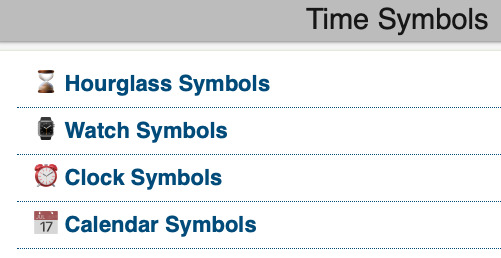
Symbols of Time Symbolic Representation of time
Date and time symbols
Date and time symbols are divided into locales, each of which is detailed in the following sections. Locale Group A Locales: af-za, en, en-au, en-be, en-bw, en-ca, en-gb, en-hk, en-ie, en-in, en-mt, en-nz, en-ph, en-sg, en-us, en-vi, en-za, fo-fo, gl-es, id, id-id, is, is-is, it, it-ch, it-it, kk-kz, ms, ms-bn, ms-my, nb-no, nl, nl-be, nl-nl, no, no-no, om-et, om-so, pl, pl-pl, pt, pt-br, pt-pt, so-dj, so-et, so-ke, so-so, sv, sv-fi, sv-se, sw-ke, sw-tz Locale Group B Locales: be-by, bg-bg, el, el-gr, fi, fi-fi, hr, hr-hr, hu, hu-hu, ja, ja-jp, ko, ko-kr, ro, ro-ro, ru, ru-ua, ru-ru, sh-yu, sk, sk-sk, sl-si, sq-al, sr-sp, th, tr, tr-tr, uk-ua, zh, zh-cn, zh-hk, zh-mo, zh-sg, zh-tw More on IBM website
Father Time Exhibition
Personification of Time Dynamic Vision Board Meta Model by Adam Pierce MHC virtual museum FATHER TIME, father time symbol, father time images, old father time, father time is grim reaper, father time mother nature, father time statue, father time vintage, baby new year
"Copy and Paste" Time Symbols

"Copy and Paste" Time Symbols Time symbol is a copy and paste text symbol that can be used in any desktop, web, or mobile applications. Every time symbol: ⌛ Hourglass done Symbol ⏳ Hourglass not done Symbol ⌚ Watch Symbol ⏰ alarm clock Symbol 🕛 twelve o’clock Symbol �� eleven o’clock Symbol HTML Hex ⌛ Day & Night Symbols Through the ages, celestial happenings and natural phenomenon have been used to symbolize important thoughts and concepts. The cyclical occurrence of day and night was one of the things occurring in nature that was believed to hold specific meaning. While different civilizations had different day & night symbols to record the passage of time, Day and Night, by themselves, were thought to have strong symbolic meanings. The recurring phenomenon of day and night was always considered very meaningful as it was believed that the survival of human species depended majorly on synchronizing the bodily and mental functions with the peculiar demands of day & night. The Day and the Night seem to present two entirely different worlds. Day and night changes even seem to have biological effects on mankind. The creatures that are aggressive, alert and seeking in the day become quiet and inactive at night. The dramatic contrast presented by Day and Night is equated with the disparity between life and death, light and darkness, consciousness and unconsciousness. Day and Night symbolize, respectively, the birth of the Sun and its death. With the rising Sun, the Day is considered representative of new life, and fresh beginnings, possibilities, hopes, and opportunities. It also symbolizes the active, masculine principle and the rise of consciousness. A lunar calendar is a calendar based upon the monthly cycles of the Moon’s phases (synodic months), in contrast to solar calendars, whose annual cycles are based only directly upon the solar year. Lunar calendar and Moon’s phases Lunar calendar, any dating system based on a year consisting of synodic months The Sumerians were probably the first to develop a calendar based entirely on the recurrence of lunar phases. Each Sumero-Babylonian month began on the first day of visibility of the new Moon.

Symbol of Time and Life - Death of Time
Time symbolism
Symbols of Life Ankh has a cross shape but with an oval loop in place of an upper bar. The origins of the symbol are not known, although many hypotheses have been proposed. It was used in writing as a triliteral sign, representing a sequence of three consonants, Ꜥ-n-ḫ. This sequence was found in several Egyptian words, including the words meaning "mirror", "floral bouquet", and "life". In art the symbol often appeared as a physical object representing either life or substances such as air or water that are related to it. It was especially commonly held in the hands of deities, or being given by them to the pharaoh, to represent their power to sustain life and to revive human souls in the afterlife. One of the most common decorative motifs in ancient Egypt and was adopted by neighbouring cultures as an artistic motif. Since the late 20th century, in the Western world, the symbol has come to be used decoratively, as a symbol of African cultural identity, Neopagan belief systems, and the Goth subculture. Symbol of Time - The Hourglass
Time is Life and Death

What is it Time of Life? The ankh is an ancient Egyptian hieroglyphic symbol that was most commonly used in writing and in art to represent the word for "life" and a symbol of Life. Its use continued through the Coptic Egyptians who adapted it as the crux ansata, a variant form of the Christian cross. Symbols of Death Symbols of Death and Time (Western) Medieval and Renaissance art made use of a number of emblems to symbolize death and mortality. Although a central theme of Christianity for hundreds of years the was triumph over death, the onset of the black plague altered public perception, and the emphasis was placed on the triumph of death over life and the necessity of repentance.
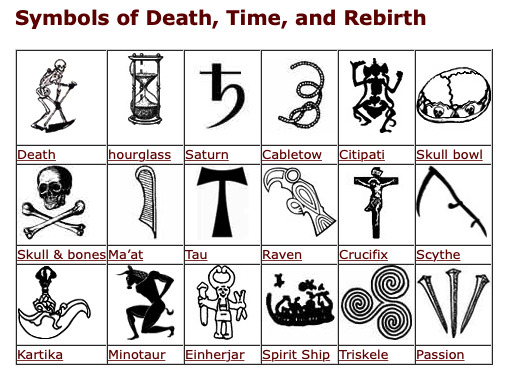
Symbols of Death, Time and Rebirth Symbols of resurrection common in Christian art became less popular as reminders of the impermanence of life and the punishments of hell became ubiquitous. The most common symbols of mortality were the grim reaper and his scythe, the death’s head, and the hourglass, all appropriated from icons of Greek and Roman Paganism. Slogans such as “remember death” and “all is vanity” were omnipresent- death was around the corner, and one had better repent if one was to avoid an eternity of damnation. The source of these macabre symbols was, ironically, the paganism that Christianity had supposedly replaced. In ancient times, the emblem of the God Saturn (Chronos to the Greeks) was the scythe, which represented the nature of the cycles of time. The scythe symbolized not only impermanence (all things living will be cut down), but the nature of the life cycle- plants must die to feed animals, and the tool of the harvest is depicts the necessity of death for the renewal of life. Thus, death was depicted as a natural part of the passage of time. The image of Chronos devouring his children seems macabre, but illustrates that the the Greeks believed the passage of time is so inevitable that even the gods were consumed by it.

Hourglass = Rebel for Life! The hourglass is another emblem of time (see Hourglass Symbolism), although hidden within is the promise of life- because the hourglass is reversible, it held within a promise of resurrection, a symbolism not lost on everyone- all of these emblems later became symbols of resurrection to Freemasons and Rosicrucians who grasped their true ancient meanings. The skull was a frequent companion to ascetic desert saints in numerous Christian artworks, and was often paired with the book, a symbol of studiousness. In this manifestation, the death’s head was less ominous, and symbolized the rejection of the impermanent material world for the life of the spirit. Mary Magdalene is probably the best known example of these two emblems in art. *Some scholars theorize that the appropriation of ancient symbolism was a subconscious (or even deliberate) attempt to appease the old gods. In later times, death was depicted as a process of the alchemical arts. Common alchemical emblems included the crow, the skull, and the tomb as symbols of the necessary death of the ego/personality. Emblems of death are also prevalent in Masonic art and symbolism. Contemplation of mortality is a frequent theme in Masonic ritual and practice (see Masonic Hourglass)
Time symbolism
Día de los Muertos The Day of the Dead is celebrated annually in Mexico on November 1st, coinciding with the Catholic observation of All Saint’s Day. The Day of the Dead is a uniquely Mexican celebration, a cultural festival resembling Halloween in many ways, but with more cultural and spiritual meaning. The holiday combines elements of Catholicism with ancient Aztec symbolism, and honors the spirits of departed ancestors and loved ones who are believed to return to earth to join in the celebrations.

Hourglass and Death on St Thomas' Church Mortality Symbols Skulls, death heads, they are often shown in profile and frequently shown with bones. Bones, shown crossed they also appear in a variety of combinations. Skeleton, lying down they feature varying anatomical details. Hourglass, lying on their sides or with wings. Coffin appearing with other symbols. Sexton’s toolsusually a pick and spade often crossed. Corpse and deathbed. Dead humans are rarely depicted in coffins but deathbed scenes are more common. Ribbon. Sometimes the symbols are tied together with a ribbon.

The symbol of Time above represents extinction. The circle signifies the planet, while the hourglass inside serves as a warning that time is rapidly running out for many species. The world is currently undergoing a mass extinction event, and this symbol is intended to help raise awareness of the urgent need for change in order to address this crisis. Estimates are that somewhere between 30,000 and 140,000 species are becoming extinct every year in what scientists have named the Holocene, or Sixth Mass Extinction. This ongoing process of destruction is being caused by the impact of human activity. Such a catastrophic loss of biodiversity is highly likely to cause widespread ecosystem collapse and consequently render the planet uninhabitable for humans. In order to spread the message as widely as possible, please create this symbol in any location you feel able to. Colors of Death Black is the color of mourning in many European cultures. Black clothing is typically worn at funerals to show mourning for the death of the person. In East Asia, white is similarly associated with mourning; it represented the purity and perfection of the deceased person's spirit. During the Victorian era, purple and grey were considered to be mourning colors in addition to black. Furthermore, in Revelation 6 in The Bible, Death is one of the four horsemen; and he rides a pale horse
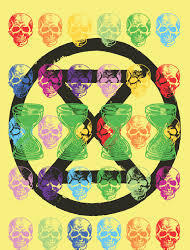
Time against Life Immortality and biblical Winged spirits The most common symbol found, they are usually found on the top of a stone. Adam and Eve Rare carvings of Adam and Eve with an apple tree and snake. Resurrection scenes Bodies rising to heaven clad only in loin cloths Open book Depicting a bible. Flaming torches Representing eternal life. Trades Hammer men All trades which require a hammer such as jewlers and cobblers often use the hammer and crown symbol. Blacksmith An anvil or farrier with a horseshoe and pincers. Tailor Showing pressing iron and shears Gardener Rake, hoe and spade Gamekeeper Gun, powder flask, fishing rod, game bird and dog. Merchant The number 4 is often used to symbolise trading with the four corners of the world and often has crosses added to the arms but sometimes a ship is used to represent overseas trade. Weaver Usually depicted with a weavers shuttle.
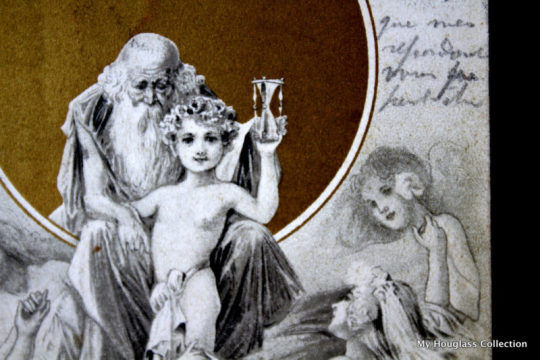
Hourglass 266, post card, Father Time Heraldry Heraldic shields show connections to a noble family but are sometimes used as a way of representing status by including trade symbols within a shield. A Briefer History of Time Stephen Hawking and Leonard Mladinow Foreword THE TITLE OF THIS BOOK DIFFERS by only two letters from that of a book first published in 1988. A Brief History of Time was on the London Sunday Times best-seller list for 237 weeks and has sold about one copy for every 750 men, women, and children on earth. It was a remarkable success for a book that addressed some of the most difficult issues in modern physics. Yet those difficult issues are also the most exciting, for they address big, basic questions: What do we really know about the universe? How do we know it? Where did the universe come from, and where is it going? Those questions were the essence of A Brief History of Time, and they are also the focus of this book. In the years since A Brief History of Time was published, feedback has come in from readers of all ages, of all professions, and from all over the world. One repeated request has been for a new version, one that maintains the essence of A Brief History yet explains the most important concepts in a clearer, more leisurely manner. Although one might expect that such a book would be entitled A Less Brief History of Time, it was also clear from the feedback that few readers are seeking a lengthy dissertation befitting a college-level course in cosmology. Thus, the present approach. In writing A Briefer History of Time we have maintained and expanded the essential content of the original book, yet taken care to maintain its length and readability. This is a briefer history indeed, for some of the more technical content has been left out, but we feel we have more than compensated for that by the more probing treatment of the material that is really the heart of the book. More: The Full History of Time

A bright pink rhinoceros emblazoned with Extinction Rebellions signature logo, next to the chancellery at the Reichstag in Berlin - Current Time Symbol
The Symbolism of Time or Kala and Death in Hinduism
The development of Vedic philosophy was centered around this most important feature of our existence. In fact the Vedas are meant to be a solution to this problem. All the ritual and spiritual practices prescribed in the Vedas are meant to resolve this fundamental problem of our existence. Every religion and tradition that originated int he Indian soil subsequently tried to address in their own ways. The Upanishads, therefore, describe Death as the Lord of creation or creation itself. Our macrocosm (the world), just as our microcosms (bodies) represent Death. The Brihadaranyaka Upanishad (1.2) describes how Death manifested. "In the beginning, there was nothing here whatsoever. Indeed, by Death only all this was enveloped, or by hunger, because hunger is death only. He created the mind thinking, “Let me have a mind.” Then, He performed worship. From that worship, water was produced. He thought, “Truly while I was worshipping, water was produced. That is why water is called Arca. Surely, water comes to him who thus knows why water came to be known as Arca.” Another name give to Death is Kala or time. Time rules our lives. We depart from here when our time comes. The fate of everything in the mortal world is shaped and controlled by Time only. Hence in Hinduism Time or Kala is equated with death. Time is one of the highest aspects of Manifested Brahman. He manifested before the worlds and beings manifested. Hence he is the foremost among the deities. More about The Symbolism of Time or Kala and Death in Hinduism: https://www.hinduwebsite.com/hinduism/essays/kala-death-symbolism.asp#fn01 time traveling symbolism
See also:
Time symbolism, Time is..., The Full History of Time, Time in physics and time Science, Symbolism of Melencolia I by Albrecht Dürer, Time and Text, DADA Time, Text, Time, MHC, Extinction Rebellion - Time against Life, The End of Time, Hourglass and Death on St Thomas’ Church, Hourglass – symbol of Death, Death does not Exist, Hourglass and Skeleton, “Hourglass and Cards” Exhibition, Father and Mother of Time, Time Hub, Time Philosophy, Time synonyms, Qualia and Time Sense, Time perception and Sense of Time, The Hourglass of Emotions, Time Travel + Time Management = Time Travel Management, The Hourglass, Hourglass History, Hourglass symbolism, Hourglass Figure, Hourglass Tattoo, Symbols of Time, Beauty Bio-Net, Father Time Department, Father Time and Mother Nature, Lunar calendar and Moon’s phases, Time Management, Time Management tools MHC SM: MHC Flikr, MHC Pinterest, MHC Facebook, MHC Instagram, MHC YouTube, MHC Twitter
The Hourglass Figure:
MHC Exhibitions: Hourglass Figure Sophia Loren by Adam PierceHourglass Figure Marilyn Monroe About Hourglass Body or Hourglass Figure Hourglass body measurements – body shape online calculator Hourglass Figure Celebrities on MHC Hourglass Figure, the movie MHC hourglass figure workout by Marten Sport Hourglass Figure Department on MHC Virtual Museum https://en.m.wikipedia.org/wiki/Symbols_of_death http://symboldictionary.net/?p=2696 https://www.encyclopedia.com/environment/encyclopedias-almanacs-transcripts-and-maps/symbolic-time ancient-symbols.com/symbols-directory/day_night_symbols.html https://www.iau.org/publications/proceedings_rules/units/ https://www.extinctionsymbol.info Lunar calendar, any dating system based on a year consisting of synodic months A lunar calendar is a calendar based upon the monthly cycles of the Moon’s phases (synodic months), in contrast to solar calendars, whose annual cycles are based only directly upon the solar year. Symbol of Time - The Hourglass See also Time Philosophy and The Full History of Time Read the full article
#alarmclockSymbol#AncientSymbols#ancientsymbolsoftime#AnyResearchisSymbolism#Clocks#Dateandtimesymbols#DeathinHinduism#DíadelosMuertos#Hourglassfact#hourglassfacts#hourglasssymbolism#MeaningofNumbers#multiplicationsign#SandClock#symbolictime#Symbolism#SymbolismofTime#SymbolismofTimeorKala#symbols#SymbolsofDeath#SymbolsofLife#symbolsofwisdom#Synchronicity#Time#Timeconstant#Timeinphysics#TimeResearch#Timesymbolscience#Timesymbolism#timetravelingsymbolism
0 notes